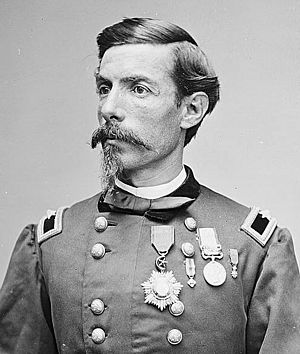Alfred N. Duffié facts for kids
Quick facts for kids
Alfred N. Duffié
|
|
|---|---|

Brig. Gen. Alfred N. Duffié
|
|
| Nickname(s) | Natti |
| Born | May 18, 1833 Paris, Kingdom of France |
| Died | November 8, 1880 (aged 47) Cádiz, Kingdom of Spain |
| Allegiance | French Second Republic United States of America Union |
| Service/ |
French Army United States Army Union Army |
| Years of service | 1852–1859 (French Army) 1861–1865 (US Army) |
| Rank | Sub-Lieutenant (France) |
| Commands held | 1st Rhode Island Cavalry |
| Battles/wars | Crimean War |
Alfred Napoléon Alexander Duffié (born May 18, 1833 – died November 8, 1880) was an important soldier and diplomat. He was French-American and fought in two major wars: the Crimean War and the American Civil War.
Contents
Early Life and Military Start
Alfred Duffié was born in Paris, France. He joined the French Imperial Cavalry in 1852. He was part of the 6th Dragoon regiment. During the Crimean War, he fought in battles like the Battle of Balaclava and the Battle of Chernaya River. He was a skilled soldier and moved up in rank.
In 1859, Duffié became a sub-lieutenant in the 3rd Hussar cavalry regiment. Soon after, he left the French army and moved to the United States. He settled on Staten Island and married into a well-known New York family.
Fighting in the American Civil War
When the American Civil War began, Duffié joined the Union Army. In August 1861, he became a captain in the 2nd New York Cavalry Regiment. He was a strong leader, though he sometimes had disagreements with other officers.
In July 1862, Duffié was chosen to lead the 1st Rhode Island Cavalry. He was given the rank of colonel. At first, the officers of the 1st Rhode Island did not want to serve under a foreign-born leader. But Duffié quickly earned their respect. He trained the unit into a very good fighting force. They fought against Confederate troops in August 1862 near Cedar Mountain, Virginia.
Key Battles and Challenges
At the Battle of Kelly's Ford in March 1863, Duffié bravely led a charge. This action forced the enemy cavalry to retreat. Later, he was promoted to lead a division of cavalry.
On June 9, 1863, Duffié's division was part of a plan to attack Confederate cavalry. They got lost at first, which made them late. When they arrived, the Battle of Brandy Station had already started. Duffié was ordered to the town of Stevensburg. There, a smaller Confederate force stopped his division. Because of this, he was moved back to leading just a regiment.
On June 17, 1863, Duffié led the 1st Rhode Island on a scouting mission. They went toward Middleburg, Virginia. He almost captured the famous Confederate cavalry leader J.E.B. Stuart. After Stuart escaped, he returned to Middleburg. Stuart then caused a big defeat for Duffié's regiment. Only 61 soldiers from the 1st Rhode Island made it back to Union lines.
Later War Service
After this, Duffié left his command and went to Washington, D.C.. He was promoted to brigadier general on June 23, 1863. He did not fight in battles again until that fall. He was then assigned to train new cavalry units in West Virginia.
His division of West Virginia volunteers fought near Lewisburg in December 1863. They also took part in General David Hunter's campaign in the Shenandoah Valley in 1864. Duffié also helped in operations against Confederate guerrilla leader John S. Mosby. He hoped to capture Mosby, who was known as the "Gray Ghost." However, Mosby's men captured Duffié instead. This happened near Bunker Hill, West Virginia, on October 20, 1864.
Duffié was sent to a prison camp. He was released on February 22, 1865. He was then ordered to Texas for a campaign. But the war ended before he could get there.
After the War
On August 24, 1865, Duffié left the army. He went back to his home on Staten Island. In 1867, he became a U.S. citizen. In 1869, he was appointed as the U.S. consul to Cadiz, Spain. A consul is a government official who helps citizens and promotes trade in a foreign country.
Alfred N. Duffié died in Cadiz, Spain, on November 8, 1880. He passed away from tuberculosis. After his death, some of his former officers from the 1st Rhode Island Cavalry raised money. They wanted to build a monument to their old leader in Providence.


